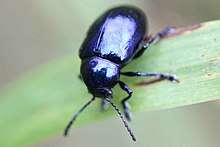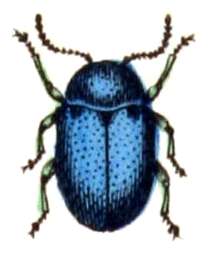Chrysochus asclepiadeus
Chrysochus asclepiadeus (or Eumolpus asclepiadeus) is a member of the leaf beetle subfamily Eumolpinae. It is considered the type species of the genus Chrysochus, though some authors have also placed the species within Eumolpus. It is the only species of Chrysochus distributed in the western Palaearctic. It is mainly found in Europe, though it is also known from Kazakhstan and Turkey in Asia.
| Chrysochus asclepiadeus | |
|---|---|
 | |
| Scientific classification | |
| Kingdom: | Animalia |
| Phylum: | Arthropoda |
| Class: | Insecta |
| Order: | Coleoptera |
| Family: | Chrysomelidae |
| Genus: | Chrysochus |
| Species: | C. asclepiadeus |
| Binomial name | |
| Chrysochus asclepiadeus (Pallas, 1773) | |
| Synonyms[1] | |
In the literature, the species is usually listed as including two subspecies, Chrysochus asclepiadeus asclepiadeus and Chrysochus asclepiadeus asiaeminoris. The nominate subspecies, C. a. asclepiadeus, has a wide distribution range in Europe, while C. a. asiaeminoris is known only from Babadağ, Denizli in southwestern Turkey (its type locality) and has not been reported since its description in 1948. In 2015, Ekiz et al. concluded that C. a. asiaeminoris is actually a synonym of the nominate subspecies.[2]
Description
C. asclepiadeus has a dark blue body with a purplish metallic reflection. Adult males have an average length of 9.3 mm and an average width of 4.9 mm. Adult females are generally similar to males, but larger; they have an average length of 10.2 mm and average width of 5.4 mm.[2]
Gallery
References
- Moseyko, A. G.; Sprecher-Uebersax, E. (2010). "Eumolpinae". In Löbl, I.; Smetana, A. (eds.). Catalogue of Palaearctic Coleoptera. Volume 6. Chrysomeloidea. Stenstrup, Denmark: Apollo Books. pp. 619–643. ISBN 978-87-88757-84-2.
- Ekiz, A. N.; Şen, İ.; Gök, A.; Turantepe, E. (2015). "Occurrence of Chrysochus asclepiadeus (Pallas, 1773) (Coleoptera: Chrysomelidae) in Turkey: two distinct subspecies or the same taxon with slightly different populations?". Zoology in the Middle East. 61 (2): 148–152. doi:10.1080/09397140.2015.1020608.

